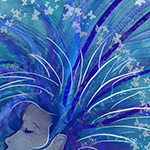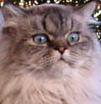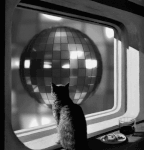|
I think the discussion on copy paper vs newsprint and was more a general discussion and not one that is necessarily directed towards you. Your plan to use pencil and paper as well as the tablet sounds fine for what you want to do. It should be np to paint a cat in photoshop and print it on some cardstock at your local fed ex store or printer of choice. Would be very cheap but would still look nice. As far as difficulty with transparency goes, you are only going to be able to draw that kind of thing once you get better at seeing. Same goes for metal and glass and that kind of thing. You should still try to draw stuff like that, just don't feel bad if it doesn't turn out well. That's what practice is for. Just keep drawing stuff around you. You should also try to draw a lot of cats from reference if you aren't already. Best way to learn to draw a thing is to draw that specific thing 50-100-10,000 (whatever your sanity allows) times. Also, I'm nitpicking here but I just want to say that you don't need "12 shades of charcoal" for anything. One cheap general's compressed 4B or 6B stick will get you a respectable range in values if you learn how to use it well. It's not about having tons of complicated specialized supplies, but instead its about having a few good versatile tools and learning how to use them well. Lifedrawing supplies aren't nearly as exotic or exciting as you make them sound.
|
|
|
|

|
| # ? Jun 9, 2024 15:14 |
|
JuniperCake posted:You should also try to draw a lot of cats from reference if you aren't already. Best way to learn to draw a thing is to draw that specific thing 50-100-10,000 (whatever your sanity allows) times. This, absolutely. quote:And if I dedicated, say, 20-30 minutes a day to practicing realistically how long would it take before I could output something decent? I don't know if it'll help, but this year I've been doing an hour of proper practice most days, my deviantart  has most of my practice pics, so that might help you judge. The thing that I've found weird, though, is that after a while, it gets easier to art for longer, and that you find yourself doing it without thinking about getting started - it's a lot like exercise in that way. Start of this year, doing half hour a day was a challenge, now it's rare that I do less than two hours, and can work on one pic for much longer before I get bored of tweaking it. has most of my practice pics, so that might help you judge. The thing that I've found weird, though, is that after a while, it gets easier to art for longer, and that you find yourself doing it without thinking about getting started - it's a lot like exercise in that way. Start of this year, doing half hour a day was a challenge, now it's rare that I do less than two hours, and can work on one pic for much longer before I get bored of tweaking it.e:  to to  in 3/4 a year. The first isn't bad, but... well, you can see the difference. I'm not trying to blow my own trumpet here, just give you an idea of what's possible, entirely self-taught (in terms of 'I haven't had classes', I've used a fair bit of online stuff), and with gently caress all spent beyond my tablet (a gift), and a ream of paper. I'd never tried to draw from life/photos before this year, it was all cartoon stuff. With drawing a cat - how long have you got, can you draw at all at the moment? You'll definitely be able to make her a card she'll love, but I'd put money that you won't like it, you'll see only the mistakes, feel like a schoolkid giving it to her, etc. petrol blue fucked around with this message at 01:03 on Sep 28, 2014 |
|
|
|
Crack posted:While this all sounds like excellent advice, I'm a poor as gently caress student and I really don't want to spend any more money than necessary. I don't want to pay for life drawing classes, and I don't have the space for massive sheets of paper, or a board to put it on. It can take years of daily practice to draw decently, even if it's just a cat. Even more so if you're starting out from zero skill. I honestly think you're better off selling the tablet and buying traditional art supplies if you want to draw something decent. If your end goal is just to draw your mother's cat to put on a birthday card and not to learn how to draw, then I think you'd be better off making a card from a photograph and adding your own fancy decorations and designs. Newsprint is by no means special paper (it's dirt cheap), no one said you needed an easel, and I only recommended one pencil with the option of two hardnesses. Store the drawing board and newsprint under your bed and set it up on your lap/lean against the desk when you're working. You don't need to go to life drawing sessions to draw from life. Life is all around you - draw a baseball or other spherical object - setup a still life on your desk - draw a self portrait from a mirror - draw your friends - draw your significant other or family members.
|
|
|
|
Billy Shears posted:It can take years of daily practice to draw decently, even if it's just a cat. Even more so if you're starting out from zero skill. I honestly think you're better off selling the tablet and buying traditional art supplies if you want to draw something decent. Eh, 'decent' changes as you learn. Sure, they won't be able to do 'photoreal' anytime soon, but a picture that your kid has spent a lot of time and effort making? What mum wouldn't be over the moon with that? Hell, draw it again for her next year, and show her exactly what you've learnt in a year, she'll love it. The most important part is having fun and being interested (otherwise you won't pay attention, and you won't learn poo poo), and a tablet opens up a lot of options that traditional media (especially on a tight budget) struggles with. Sure, it's an advanced tool, but that doesn't mean you can't have great fun learning how to use it while you practice the basics elsewhere.
|
|
|
|
petrol blue posted:Eh, 'decent' changes as you learn. Sure, they won't be able to do 'photoreal' anytime soon, but a picture that your kid has spent a lot of time and effort making? What mum wouldn't be over the moon with that? Hell, draw it again for her next year, and show her exactly what you've learnt in a year, she'll love it. No doubt that his mom will love it no matter what, it's the self critiques that really get to you. A tablet can definitely give you lots of flexibility, but I'm weary of recommending it as the starting point for someone with zero experience. I can't imagine learning gesture without first learning to loosen up on something large - it's probably the best way to learn gesture and break the habit of petting your lines.
|
|
|
|
They're in french but here's artistic anatomy by Paul Richer. You can download the entire book as a pdf. Female version. Male Version. East Lake fucked around with this message at 02:08 on Oct 1, 2014 |
|
|
|
Wow, just watched Proko's videos on gesture drawing, and holy balls is it hard. https://www.youtube.com/playlist?list=PLtG4P3lq8RHGuMuprDarMz_Y9Fbw_d2ws for the curious. All this time with Drawing on the Right Side of the Brain she's teaching you to see all the little details in how something is put together, and now Proko's asking me to forget the little details and draw a whole picture in 2 minutes or less, preferably 30 seconds. It's crazy, it's like I'm learning to see all over again for a third time. That said, are Proko's premium videos worth it, or is there not much more there than his free videos?
|
|
|
|
TwoQuestions posted:Wow, just watched Proko's videos on gesture drawing, and holy balls is it hard. https://www.youtube.com/playlist?list=PLtG4P3lq8RHGuMuprDarMz_Y9Fbw_d2ws for the curious. All this time with Drawing on the Right Side of the Brain she's teaching you to see all the little details in how something is put together, and now Proko's asking me to forget the little details and draw a whole picture in 2 minutes or less, preferably 30 seconds. It's crazy, it's like I'm learning to see all over again for a third time.
|
|
|
|
TwoQuestions posted:Wow, just watched Proko's videos on gesture drawing, and holy balls is it hard. https://www.youtube.com/playlist?list=PLtG4P3lq8RHGuMuprDarMz_Y9Fbw_d2ws for the curious. All this time with Drawing on the Right Side of the Brain she's teaching you to see all the little details in how something is put together, and now Proko's asking me to forget the little details and draw a whole picture in 2 minutes or less, preferably 30 seconds. It's crazy, it's like I'm learning to see all over again for a third time. I think they're worth it. He throws a ton of example videos at you with the premium content, which makes it worth it so you can follow along and get a better feel for different poses.
|
|
|
|
I'd definitely recommend the Figure Drawing premium stuff (the videos have a lot more instruction packed into them, along with downloadable diagrams for things like proportions), but the Portrait Drawing premium stuff is a bit iffier. Its only major advantage is that it comes with two 1 hour-ish a piece videos that show two complete portrait drawings, which can be useful to see how he brings them all together. Other than that, though, you're not getting much for the purchase price. Highly recommend his stock, also. You end up getting a huge number of images (the one I've been practicing on recently, Veronica, has 433 images!) for really cheap, and they're all professionally lit with an excellent selection of different poses.
|
|
|
|
Oooh, I'd been looking at those and being not sure for ages - been working on a custom version of the gesture-drawing-tools like pixelovely's, and it needs random pics to choose from, those would be perfect. Not for sale, obviously, just kept getting annoyed by the lack of a timer or a few seconds' gap to change paper, figured I'd do a custom one.
|
|
|
|
Are there any good reference guides for constructing animals in perspective from 3D shapes? I'm having trouble visualising long noses and snouts, but the best I can find use 2D shapes, which really isn't helping my sense of spacial awareness.
|
|
|
|
Introduction to Animal Anatomy with Marshall Vandruff This is $40 for a digital download and worth every penny. His perspective series is also a steal at $12.
|
|
|
|
I apologize if this has been asked before, but I am somwhat torn on what media I should practice on. I've had some rudimentary drawing classes but now I've been trying to get into doing things a bit more precisely. It seems like my end goal is to get into digital drawing/painting, like the rest of my generation, but for now I feel like I should stick with what I know, paper sketching, until I improve that then really move on to digital. My question is this: Does the thread think I should focus more on digital drawing when I am home and just stick to pencil when I am away from my computer, or should I practice with the pencil until I feel more comfortable with it? I am hoping to get into some evening drawing classes at a local community college soon (I already went to university so now I have to navigate their acceptance system oddly), so I hesitate to completely drop the sketchbook, but I also have a Intuos tablet rotting away otherwise. CuddleCryptid fucked around with this message at 17:31 on Nov 8, 2014 |
|
|
|
|
Well, in a way, you don't have a choice - you have to do both. Digital, because that's the medium you want to do, and pencil / paper because you have to go out into the world and draw what you see. You won't damage anything by switching between the two - so indulge both!
|
|
|
|
|
Learning how to work traditionally will help you better understand the mediums when you use them digitally - what you can and can't get away with, what techniques work, etc. I'd say work with both. Another thing to consider is that when you work traditionally you'll then have an original to hold in your hands. There's nothing that can quite compare to that digitally.
|
|
|
|
Do you guys have any advice for color selection when you're doing digital painting? I know if I'm painting from a photograph I could eyedropper my way through, but I also know I wouldn't learn anything doing it that way. Looking at the texture studies in the current daily drawings thread, it's obvious the artists have color picking down to a routine, but it's still something I have difficulty with. At the moment, I have what I know is an unorthodox approach… I use ArtRage and start with its preset pigments that approximate real-life oil/watercolor pigments (like alizarin or Prussian blue or burnt sienna and so on) and use ArtRage as an ersatz mixing palette. I know I could just do the Ctrl-Paint 50% Flow approach. But my way gives my colors a sense of unity that makes them feel more naturalistic. That said, it takes a prohibitive amount of time. I've also experimented with trying to adjust H/S/L values myself to visually match a color swatch, but I don't feel like I'm learning to see heat or cold in the colors when I do it that way. This is the thing that takes me the longest by far when I paint digitally, so I feel like there has to exist a better way. Any ideas?
|
|
|
|
http://forums.somethingawful.com/showthread.php?threadid=3386435&userid=0&perpage=40&pagenumber=47#post397468659 Old post but it was awesome so I book marked it. Might not help so much with selecting colors for a photograph but I think it would help with creating palates in general.
|
|
|
|
JuniperCake posted:http://forums.somethingawful.com/showthread.php?threadid=3386435&userid=0&perpage=40&pagenumber=47#post397468659
|
|
|
|
CloseFriend posted:Holy gently caress, that makes so much sense now that I see it. Thanks!! Yay, I'm always happy when this thing comes back. Anyway I updated that a little bit and made a video of it a few years back: https://www.youtube.com/watch?v=slm9uZQ4mqQ Also, these days I use this plugin for Photoshop: http://www.coolorus.com/ neonnoodle fucked around with this message at 15:54 on Dec 9, 2014 |
|
|
|
Hey, thanks for that, neonnoodle, I've not had a chance to try it yet, but I get the idea, and it's a drat good one. Got a million things I'm working on at the moment - trying to loosen up (and stop stresssing details), to 'paint' instead of 'sketch', to work on colours... Pretty pleased with today's pic, ~2h from life. I'm absolutely stunned by my progress this year, and it started with 'spend half hour every day practising'. (Android tablets getting so good for digital painting sure doesn't hurt any, mind!)  My question is - how's my colour balance? I'm constantly bugged by the way every pic I do on my tablet looks really washed out on my (pretty old) desktop monitor, and only looks ok after photoshop ramping up the contrast tons. The original is left, the adjusted right - which looks better to goons?  
|
|
|
|
Crack posted:While this all sounds like excellent advice, I'm a poor as gently caress student and I really don't want to spend any more money than necessary. I don't want to pay for life drawing classes, and I don't have the space for massive sheets of paper, or a board to put it on. I just hosted a fairly prominent professional artist (long career, well-published) who does everything with a 2B pencil and standard-grade drawing paper. She has so much experience with graphite that's she's basically mastered what you can do with a lowly 2B. Start with basic materials, you'll be able to tell if they start holding you back at some point. But holy hell, the money for even just one session of a life drawing is completely worth it. In my town, there's a life drawing meetup group for a very reasonable price. There's no direct instruction, although you can ask for advice and feedback if you want. Working in a nice studio with a live model can really go a long way if something like that exists near you.
|
|
|
|
I hope this thread hasn't died completely. I had an ever so slight burnout after hauling rear end during my studies with a new job and a big workload, and I needed something entirely else to focus on, so I decided to start drawing. I've never really drawed anything beyond doodles and ornate cubes, but I've always stared in awe at drawings/architecture/art, and wished I could create something similar. It's been really cool because I feel so much progress in so few drawings. Spending a lot of time and not rushing it has been key. Forcing myself to try new things, erasing and drawing again has helped a lot. I've been drawing from reference, practicing and learning a bit about perspective in between the drawings. In the last one I did get a bit lazy towards the end, so you can see that not everything aligns perfectly, but regardless I am satisfied. Whenever I got something I thought looked good, I did get a feeling that if I added more to it, I would just end up ruining whatever I already had, but I just got to push through it I guess. I feel lucky in that I didn't try to draw from more complex references, because then I would be working on the same piece a week from now. If anyone has critique or tips on technique or other things to draw, then feel free.   
|
|
|
|
These are really your "just starting out"-drawings? Then gently caress you, and well done. Especially the second one looks like nothing I'd expect to come from someone who has just started getting serious about drawing. Especially the way you're losing edges (no drawing a complete line, but partially implying it) some places is very nice, many people wrongfully try to put in edges places where they "know" they should be. Anyway, keep doing what you're doing! Photostudies paired up with perspective practice is great. For your line drawings, you can try making your shadow-side lines thicker and brighter, while keeping the edges on the lit side thin and sharp (perhaps losing those too some places). And for whatever drawing needs I always recommend this page, it has .. everything. http://www.pinterest.com/characterdesigh/ If you want more specific tips for drawing something in particular that also helps with pointing you in a direction or giving critique.
|
|
|
|
quote:many people wrongfully try to put in edges places where they "know" they should be. I'm having some issues with figuring out lighting on this little thing. I haven't tried drawing in a good few years, so I'm pretty sure my perspective is hosed somehow as well. I can post the clean image as well, but this is as much as I think I've figured out. After this hurdle it'll be trying to colour it so it isn't just flat and boring. 
|
|
|
|
Lighting on the figure looks consistent (about 4 O'clock?), but the big rock looks a touch too much, uh... on 3 O'clock. Hard to describe. Adding a couple of highlights/shadows on the most extreme scales might sell the texture more? And yeah, utterly agreed on the 'what is vs. what 'should be'', I've spent the last year trying to break that, and still only feel like I'm starting to get it!
|
|
|
|
Seeing as it was a drawthread request I decided to trying something a bit more out there, at least for me, and I'd love for someone to give it a bit of a critique so I know what to improve next time. I'm already certain that I've got its left arm in a kind of broken position, and there's something funky going on with the perspective towards the bottom half. Also not sure if this is a good idea but I've found that going through draw threads like on /tg/ is great for finding things you wouldn't usually think to try drawing.  
|
|
|
|
I don't know what the hell. I tried to do some gesture type drawings after watching Proko again to figure out what the hell to do, and I keep getting stick figures instead of anything resembling what he gets. Can anyone here help me figure out what I'm messing up? I'm going for 1 minute poses.
|
|
|
|
the thing that really worked for me was to make it even simpler. Like, do ten of them drawing just one line for the spine, draw a few more showing 'the spine-line crossed by the shoulder line and hip line'. I've been doing these almost every day for the last year, and I'm only just now starting to internalise the idea that I'm not trying to make a 'proper' drawing. What you're aiming to draw is a framework that you could hang a 'proper' figure on when you come back to it later. It probably wouldn't take anyone else so long, but I'm a dumbass obsessed with detail.
|
|
|
|
I haven't made any attempt to do traditional art in years, but I've started sketching again lately, and I forgot how much I enjoy it. I'm really interested in trying to learn how to use watercolor pencils. Could anyone recommend a good brand? Or a good paper brand, as well? Thanks! Edit: Here's my first attempt at digital painting that I made yesterday. It's super simple, but I haven't done anything beyond doodling in about a decade, so I was pretty proud of it.  I wanted to share it because it sorta shows the style that I'm attracted to - I like working with intense (but tasteful) bursts of color, and doing a lot of manual blending and whatnot. I was thinking watercolor pencil might be a great medium for that, but I'm definitely open to any other suggestions I wanted to share it because it sorta shows the style that I'm attracted to - I like working with intense (but tasteful) bursts of color, and doing a lot of manual blending and whatnot. I was thinking watercolor pencil might be a great medium for that, but I'm definitely open to any other suggestions  
discoukulele fucked around with this message at 22:18 on Jan 21, 2015 |
|
|
|
JuniperCake posted:Best way to learn to draw a thing is to draw that specific thing 50-100-10,000 (whatever your sanity allows) times. Best way to draw one specific thing 10^5 times: very small. Furthermore, if you draw lots of the same thing very small and all right next to each other, then not only are you completing a drawing in under a minute, you are also referencing each one for the next at a glance. It's a simple and obvious trick but sometimes the most simple and obvious things go whizzing right over. Any time someone asks me to draw something and I realize that I don't actually know exactly how part of it looks I fill a page with 20+ quarter sized sketches as quickly as possible, forgoing specifics in favor of fundamental shape and flow. I find that by the end of the page I've learned shitloads.
|
|
|
|
I may have to try exactly this, thanks for the advice.
|
|
|
|
Doctor_Fruitbat posted:Are there any good reference guides for constructing animals in perspective from 3D shapes? Youtube's full of videos of animals. Watching them in movement helps. I often have to think about the skeleton and intentionally strip away the finer details of the animal first to wrap my head around a new body shape; By understanding the skull of a wolf I can draw the face of a wolf more accurately and interestingly. *you can also photograph and record them, however you must look at the real thing with your real eyes. I could launch into a massive rant about this guy in a life drawing class who took a polaroid of the model and pinned it next to his canvas but that's beside the point. i am harry fucked around with this message at 00:53 on Jan 26, 2015 |
|
|
|
Yeah, just going out and viewing things is the best way at getting better at drawing them. Do the same basic exercise with everything you're trying to learn to draw: figure out how you can reduce it down to a few basic cubes or spheres and go from there. My human drawings improved by a loving load once I started doing insanely simple oval ribcages and pelvis bowls (along with a lot of observation and practice).
|
|
|
|
Thanks guys; by sheer coincidence I had a stab at using ovals and bowls for constructing figures today and it immediately made them look better, so I'll be doing a whole lot more of that this week. There's actually a museum local to me with stuffed animals, so I'll mosey on down and look. It has a collections study centre specifically for studying things up close... Which isn't open evenings or weekends. What the actual poo poo.
|
|
|
|
ijyt posted:Seeing as it was a drawthread request I decided to trying something a bit more out there, at least for me, and I'd love for someone to give it a bit of a critique so I know what to improve next time. I'm already certain that I've got its left arm in a kind of broken position, and there's something funky going on with the perspective towards the bottom half. Okay here you go, I'll try to include stuff for other readers too: If you really care about the end result, thumbnails must come first. Lots of thumbnails. Thumbnails allow you to quickly sketch out composition, and if you do four or five quick, different compositions, you'll naturally be drawn to the most interesting and dynamic. Often in art and in life it is easier to decide what you shouldn't do than what you should do. Seeing thumbnails lined up next to each other also allows you to decide what not to do. Slightly useful examples from poo poo on my IG: http://instagram.com/p/cw9KaXF4_A (quick example of drawing the same thing lots of times, small and in the same place) http://instagram.com/p/kp5VCLl420 (sharpie on tracing paper, cap is up top for scale reference) http://instagram.com/p/g4AocOF4-u -> http://instagram.com/p/hOkWc5l478 Moving on to anatomy: All living creatures on this planet and in our imagination follow the same principle foundations of structural creation (aside from sentient floating crystals and stuff). They all have bones, joints, muscle, and they all work the same way. If you look at a limb, or a figure, your brain is taking measurements and comparing what it sees to what it knows; If something looks wrong there's a good chance that it is. The more you look, the better you get at it. With that in mind, you live during a time when it is exceptionally easy to get a mirror (or digitally a smart phone) and look at yourself and your body parts. If I'm trying to figure out what the muscular structure of a dragons shoulder should look like, I look at my own. If I want to see what an arm looks like mid-throw, I'll look at myself in a mirror in the same position. I would say that the arm on the right is a problem because it is too far back. Were you to rotate this figure clockwise, you'd find that arm bent way behind the rest of the body almost as if it was trying to scratch the back of its head. Fixing that issue may not require redrawing the arm at an adjusted angle, you might simply try moving some of the front of that shoulder grass stuff out of the way, so you're using a prop to imply shape and position rather than the limb itself.. Lighting: Do not be afraid of light. Lighting is as easy as perspective, and perspective is simply a horizon line and vanishing points. Light radiates in straight lines in all directions. (It also bounces around and refracts and stuff but don't think about any of that yet) Re: Hand on the left: If you are holding a hand in front of your face and there is bright blue light coming out of it, it will be illuminating your face. If you are holding a hand to the side of your face it may not illuminate the side of your face, but it will illuminate your body and your legs. If you're working with light, then you use the light to describe form. If you put some illumination on the creature's thighs, you'll imply that they are angled differently from the lower legs, which bend at the knees. You cannot illustrate without being comfortable with light. How does one become comfortable with light? By studying it. Get some simple white shapes, like a box and a styrofoam ball and a toilet paper roll, and stick them on a table in a corner and shine a lamp on them and draw them (small) with a piece of printer paper and a no.2 pencil, paying particular attention to shadows. Then rearrange them and repeat. One of the main problems with drawing anything is crossing the bridge between what your brain thinks it knows and what you're actually seeing. Without training, your brain will naturally think it knows exactly what an arm looks like (or worse, a hand), and it is pretty much always wrong. Not completely wrong, but off enough to make it look wonky and require redrawing. The more you look at things the less your head tries to get in the way. All those mail-order art lesson commercials on TV revolve around breaking up your brain talk. They give you a portrait, give you a grid to put on top of it that corresponds to grid lines on a piece of paper, and then crucially, have you turn the portrait upside down before drawing. That way you're not thinking about eyes, mouth, nose, proportion...just lines and shapes. i am harry fucked around with this message at 16:30 on Jan 27, 2015 |
|
|
|
Thanks for that, I reckon I'm going to be coming back to that post a fair bit!
|
|
|
|
TwoQuestions posted:I don't know what the hell. I tried to do some gesture type drawings after watching Proko again to figure out what the hell to do, and I keep getting stick figures instead of anything resembling what he gets. Can anyone here help me figure out what I'm messing up? I'm going for 1 minute poses. It's all about practice. Drawing 1 minute poses as a beginner is very important, but very difficult and often discouraging. The best advice I can give is to work on setting a procedure for yourself for each pose. For me, I start with the head, then the sweep of the neck, which sometimes flows into the center line of the figure or the longest line of action. That tends to flow into one of the limbs, so I then finish with drawing the rest of the limbs. I highly recommend Proko's premium content on figure drawing. He has dozens of short pose examples that you can practice from.
|
|
|
|
On a practical level, I totally agree with the above, however it is arguably more important to discuss the mental side of it: Gesture drawings are not about working, not about thinking. They are about simply loosening up firstly, capturing movement or flow or form thereafter. Extreme gesture drawing: Start by devaluing everything you're doing (except your model. get a model to stand naked and be prepared to move around a bunch, chill music helps). Get a large sheet of cheap brown paper and a stick of charcoal that has no value, fold the paper a bunch and then unfold it so you have a series of rectangles, each one for a 10 second pose. Draw first pose for 10 sec, have model move when the time runs out, move to second section and repeat until the page is full. Should take you all of 2 minutes. Throw paper on ground, repeat folds, change pose time to 30sec, repeat. Repeat for 1min. Step back and look at everything you've accomplished, then ball that poo poo up and throw it away. In under 30 minutes, you have sufficiently limbered up your brain and your arm and your wrist to make the elegant marks and lines that underpin good life drawing, and trained yourself to look at the edges and subtle curves via 20+ drawings. In this case, it will always be better to focus on quantity over quality.
|
|
|
|

|
| # ? Jun 9, 2024 15:14 |
|
I watched a video last night on Sycra's youtube channel that went over the drawing method in Drawing on the Right Side of the Brain, basically saying that her method was more like advanced tracing than actual art, that you aren't an artist if you just draw what you see rather than "understanding" what you see. Is it possible to build an understanding of what you see from sufficient drawing of what you see, or is acquiring that skill as impossible to acquire if you learn to draw too late? Also, are there some good art books beside the aforementioned DotRSotB? I gotta get my basic drawing down before I can move on to something as hard as figure drawing.
|
|
|





















